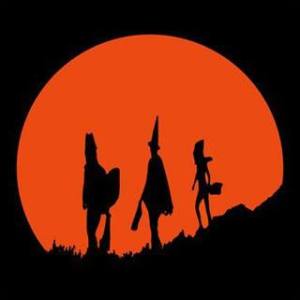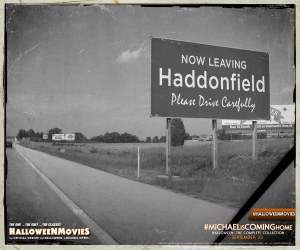Trick… or treat?
“Single-minded shocker with virtually no plot, just a succession of bloody attacks in semi-darkness. Very well done if you like that kind of thing” – Leslie Halliwell.
What better movie to celebrate the night of pumpkins, dodgy costumes and candy than Halloween? Made on a shoestring budget during one month in 1978, it became a huge commercial success, spawning a bag of sequels, a remake and scores of inferior copycats.
Once upon a time, horror movies consisted of vampires or werewolves; enjoyed a limited audience (if at all); and received even less (if any) critical attention. The astonishing success of The Exorcist (1973) awoke other filmmakers to the terrific popular and lucrative potential that the horror genre could bring.
Wes Craven’s Last House On The Left (1974), Tobe Hooper’s Texas Chainsaw Massacre (1975) and Brian De Palma’s Carrie (1976) were all landmark features, unleashing a new breed of horror movies on an unsuspecting mainstream audience. Fortunately produced outside the Hollywood system, they excelled as low-budget but visionary frighteners, introducing a more confrontational – and ultimately more horrifying – style of filmmaking.
“[Jamie Lee Curtis] was just one of several girls auditioning for Halloween. She came in to read. She had a tremendous quality… Different! Very tomboyish in a way… And I never knew she was related to Janet Leigh at all!” – John Carpenter.
Directed by John Carpenter – who had received moderate success with Assault on Precinct 13 – and produced by then-partner Debra Hill, Halloween showed how real horror is unexpected and unfathomable, and can occur in the most mundane places. It showed the escaped killer: Michael Myers stalking a group of girls on a seemingly ordnary October 31st. By concentrating the suspense on a quiet and leafy neighbourhood in (fictional) Haddonfield, Illinois, it brought the horror – the dark side of suburbia – closer to home.
Halloween (1978) introduced a more gritty type of cinematic fright. It is distinctive in its use of hand-held camera shots, but the fear is arguably heightened immensely through Carpenter’s own eerie synthesizer score. He was heavily influenced by The Thing From Another World (1951) – the film which just happens to be showing on TV that night.
“I’m not the Godfather of Gore!” Carpenter protested, as a slew of unwelcome slasher movies flooded the market during the 80s; it is unfair that he has been blamed for their proliferation. Yes, he made a really creepy film in 1978, but no, he cannot be held responsible for a subgenre which relegated young girls to mere murder objects… in the name of movie entertainment!
Donald Pleasance played Dr. Loomis (a nod to one of the main characters of Psycho), but it is interesting to learn that Carpenter had sought both Peter Cushing and Christopher Lee to play this role, but they turned him down! No offence to Pleasance (who puts in a reasonable performance) but either of the two first choices would certainly have enhanced proceedings considerably.
“People were diappointed because they were expecting to see Jamie Lee Curtis and the Shape… we kept saying: “Look guys, it’s let’s just call it Season of the Witch, it’ll do better,” but they wouldn’t listen…” – Debra Hill.
Despite the lacklustre outing of Halloween 2 (1981) – a sequel so inconsequential it has sunk without trace – the powers-that-be sought a Halloween 3. This time, there was a problem: John Carpenter was preoccupied with other projects, and Jamie Lee Curtis had baulked at the prospect of returning once more to play the babysitter-in-danger. Joe (Gremlins) Dante had suggested dropping Michael Myers and trying something more macabre. In 1982, he was fighting a losing battle to develop a Creature From The Black Lagoon remake, so would have been available to handle a third Halloween movie. Luckily, Nigel (Quatermass) Kneale was called in to work on a prospective script.
However, the end product proved too bizarre and so far removed from the original killer-in-a-mask premise that potential audiences boycotted it; Dante had left ages ago, and having seen his script rehashed beyond recognition, Kneale requested to have his name dropped from the credits. The result was a true oddity: reviled then and now looking embarrassingly incongruous amidst an otherwise well-regarded cult franchise.
This is a pity, for Halloween 3: Season of The Witch (1982) started so well: a frightened man pursued through a dark and stormy night by a band of mysterious smartly-dressed henchmen, accompanied by one-helluva-moody soundtrack (again supplied by John Carpenter, and probably superior to the score of the original movie) before descending into a mediocre and unwatchable mess.
During the 90s, further sequels brought back Michael Myers; there was even H20 (1998). To celebrate the original film’s 20th Anniversary, Jamie Lee Curtis returned to face her nemesis one last time.
In conclusion then, the impact that Carpenter and his fellow directors had on the genre was best summed up by master horror writer, Stephen King:
“They never had nightmares – they just gave them to us.”






Very cool nice write up! Happy Halloween!
Thank you for stopping by! Knew u’d like it!
Cheers!
Awesome glad I did!
Very cool article. Yeah Halloween was not as gory as the ones made after it, but it sure was way more effective in earning it’s scares. Some great tidbits about Halloween III which is vastly underrated
Thank you for your Comment, Vern!
Cheers!
” They never had nightmares – they just gave them to us.” Awwww….. Happy halloweeennnn..Mmmuuaaahhhh
Hahaha! Thanks for viewing this Post as well!
Goodness knows what Christmas will bring…!!
Cheers!